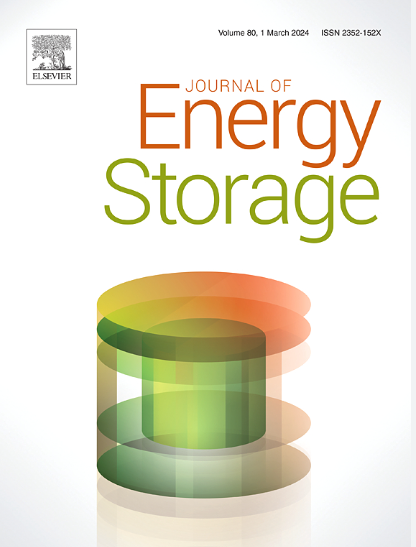DC microgrid operation with hybrid energy storage considering islanding constraints and demand response coordination: A bi-level Stackelberg game approach
IF 8.9
2区 工程技术
Q1 ENERGY & FUELS
引用次数: 0
Abstract
DC microgrid (DCG) is becoming popular for niche applications due to multiple advantages over AC microgrids (G). However, operation of a DCG is challenging due to uncertainties of renewable energy source (RES) generation and load demands, limited availability of controllable generation, and unintended islanding events. Sectoral coupling between electricity and hydrogen (), hybrid energy storage system (HESS), and demand response (DR) implementation address the challenges and enhance the techno-economic benefits of DCG operation. Further, incorporating islanding constraints in the scheduling strategy improves the security of system operation. The objective of this paper is to develop an energy management scheme (EMS) for an electricity- grid-connected DCG with a HESS incorporating islanding constraints and DR implementation in an uncertain environment with correlated and uncorrelated input uncertainties to maximize the profit of the DCG operator (DCGO), minimize the electricity usage cost of consumers, and ensure secure operation after unintended islanding using bi-level optimization.DCG network level, equipment level, and consumer’s apparatus level operating security constraints are considered in the EMS. Uncertainties of input random variables (RV) and their correlation are modelled using Copula theory and incorporated in the EMS. The DCG consists of a gas turbine (GT), power to hydrogen (P2H), hydrogen to power (H2P), HESS (comprising battery energy storage system (BESS) and hydrogen storage system (HSS)), wind power generation (WPG), solar power generation (SPG), and consumers. The consumers have non-flexible and flexible loads (thermostatically controlled load (TCL) and plug-in hybrid electric vehicles (PHEV)). The proposed EMS is modelled using a bi-level leader–follower Stackelberg game (SG) architecture, in which the DCGO is the leader and the consumers are followers. The DCGO optimally schedules flexible resources within its control and sets the retail power price (RPP) to maximize the operating profit. Consumers participate in the DR program by adjusting flexible demands according to the RPP to minimize the cost of electricity use. The dynamic RPP acts as the bridge between the upper and lower-level problems. The bi-level EMS is reformulated as a single-level mixed-integer linear programming (MILP) problem by successively using Karush–Kuhn–Tucker (KKT) conditions, the big-M method, and the strong duality theory. The MILP problem is solved in the MATLAB environment with the YALMIP toolbox and GUROBI solver. Simulation studies reveal that the proposed approach balances the interests of the DCGO and the consumers, ensures secure operation after unintended islanding, reduces RES curtailment, reduces the electricity usage cost of the consumers, and enhances the profit of the DCGO. For the system under study, the profit of the DCGO increases by while the cost of energy use of the flexible consumers is reduced by .
考虑孤岛约束和需求响应协调的混合储能直流微电网运行:双层斯塔克尔伯格博弈方法
与交流微电网(μG)相比,直流微电网(DCμG)具有多种优势,因此在利基应用中越来越受欢迎。然而,由于可再生能源(RES)发电和负载需求的不确定性、可控发电的有限可用性以及意外孤岛事件,直流微电网的运行具有挑战性。电力与氢气 (H2)、混合储能系统 (HESS) 和需求响应 (DR) 之间的部门耦合可以应对这些挑战,并提高直流微网运行的技术经济效益。此外,将孤岛约束纳入调度策略还能提高系统运行的安全性。本文的目的是在具有相关和不相关输入不确定性的不确定环境中,为具有 HESS 的电力-H2 并网直流微网开发一种能源管理方案(EMS),其中包含孤岛约束和 DR 实施,以利用双级优化实现直流微网运营商(DCμGO)利润最大化、用户用电成本最小化,并确保意外孤岛后的安全运行。输入随机变量(RV)的不确定性及其相关性采用 Copula 理论建模,并纳入 EMS。DCμG 由燃气轮机 (GT)、氢能发电 (P2H)、氢能发电 (H2P)、氢储能系统 (包括电池储能系统 (BESS) 和氢储能系统 (HSS))、风力发电 (WPG)、太阳能发电 (SPG) 和消费者组成。用户包括非灵活负载和灵活负载(恒温控制负载 (TCL) 和插电式混合动力电动汽车 (PHEV))。拟议的 EMS 采用双层领导者-追随者斯塔克尔伯格博弈(SG)架构建模,其中 DCμGO 为领导者,消费者为追随者。DCμGO 在其控制范围内对灵活资源进行优化调度,并设定零售电价 (RPP),以实现运营利润最大化。消费者参与 DR 计划,根据 RPP 调整灵活需求,以最大限度地降低用电成本。动态 RPP 是连接上层和下层问题的桥梁。通过先后使用 Karush-Kuhn-Tucker (KKT) 条件、Big-M 方法和强对偶理论,将双层 EMS 问题重新表述为单层混合整数线性规划 (MILP) 问题。MILP 问题是在 MATLAB 环境中利用 YALMIP 工具箱和 GUROBI 求解器求解的。仿真研究表明,所提出的方法平衡了 DCμGO 和用户的利益,确保了意外孤岛后的安全运行,减少了可再生能源的削减,降低了用户的用电成本,提高了 DCμGO 的利润。在所研究的系统中,DCμGO 的利润增加了 ∼ 2.22%,而灵活用户的用电成本降低了 ∼ 18.05%。
本文章由计算机程序翻译,如有差异,请以英文原文为准。
求助全文
约1分钟内获得全文
求助全文
来源期刊

Journal of energy storage
Energy-Renewable Energy, Sustainability and the Environment
CiteScore
11.80
自引率
24.50%
发文量
2262
审稿时长
69 days
期刊介绍:
Journal of energy storage focusses on all aspects of energy storage, in particular systems integration, electric grid integration, modelling and analysis, novel energy storage technologies, sizing and management strategies, business models for operation of storage systems and energy storage developments worldwide.
 求助内容:
求助内容: 应助结果提醒方式:
应助结果提醒方式:


